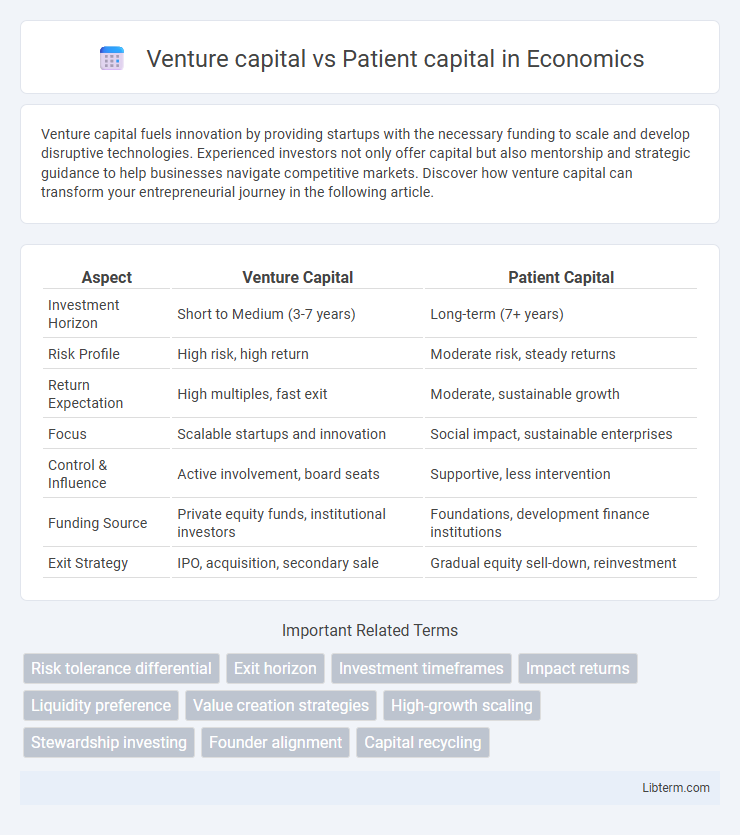Venture capital fuels innovation by providing startups with the necessary funding to scale and develop disruptive technologies. Experienced investors not only offer capital but also mentorship and strategic guidance to help businesses navigate competitive markets. Discover how venture capital can transform your entrepreneurial journey in the following article.
Table of Comparison
| Aspect | Venture Capital | Patient Capital |
|---|---|---|
| Investment Horizon | Short to Medium (3-7 years) | Long-term (7+ years) |
| Risk Profile | High risk, high return | Moderate risk, steady returns |
| Return Expectation | High multiples, fast exit | Moderate, sustainable growth |
| Focus | Scalable startups and innovation | Social impact, sustainable enterprises |
| Control & Influence | Active involvement, board seats | Supportive, less intervention |
| Funding Source | Private equity funds, institutional investors | Foundations, development finance institutions |
| Exit Strategy | IPO, acquisition, secondary sale | Gradual equity sell-down, reinvestment |
Introduction to Venture Capital and Patient Capital
Venture capital involves high-risk investments in early-stage startups with the goal of achieving rapid growth and significant financial returns, typically within a 5 to 10-year horizon. Patient capital emphasizes long-term investment strategies, providing flexible funding to businesses focused on sustainable growth and social impact rather than immediate profit. Both forms of capital are essential in driving innovation, but patient capital supports ventures requiring extended timeframes to mature and deliver value.
Defining Venture Capital: Key Characteristics
Venture capital is a form of private equity financing focused on high-growth startups and early-stage companies with scalable business models and significant market potential. It typically involves equity investment in exchange for ownership stakes, emphasizing rapid growth, innovation, and high returns within a 5 to 7-year exit horizon. Venture capital investors actively support portfolio companies through strategic guidance, networks, and operational expertise to accelerate expansion and maximize value creation.
Understanding Patient Capital: Core Principles
Patient capital prioritizes long-term impact over immediate financial returns, often supporting ventures addressing complex social or environmental challenges. It embraces flexible timelines and tolerates higher risk, recognizing that sustainable solutions require extended development periods and iterative growth. Unlike conventional venture capital driven by rapid exit strategies, patient capital aligns investor and social goals through enduring commitment and value creation.
Investment Goals: Short-Term Gains vs. Long-Term Impact
Venture capital primarily targets short-term gains by investing in high-growth startups with the expectation of rapid returns within a few years, often through exits like IPOs or acquisitions. Patient capital emphasizes long-term impact by supporting businesses that prioritize sustainable growth and social or environmental benefits, accepting slower financial returns over an extended period. This distinction influences investment strategies, risk tolerance, and the types of companies each capital type funds.
Risk Tolerance and Investment Horizon
Venture capital involves high risk tolerance with expectations of rapid growth and exit within 5 to 7 years, targeting disruptive startups and innovative technologies. Patient capital carries lower risk tolerance, emphasizing long-term commitment often spanning decades, supporting sustainable businesses aiming for steady returns and social impact. Investment horizon for venture capital is short to medium term, while patient capital aligns with extended timelines to nurture gradual value creation.
Funding Stages and Deal Structures
Venture capital typically targets early to mid-stage funding rounds such as Seed, Series A, and Series B, focusing on high-growth startups with equity-based deal structures emphasizing shares and control rights. Patient capital invests in longer-term horizons, often supporting growth and expansion stages with flexible deal structures that may include debt, revenue-sharing, or equity hybrid instruments to align with sustainable development goals. The contrast in funding stages reflects venture capital's preference for rapid scaling and exit timelines, while patient capital prioritizes steady value creation and social impact over extended periods.
Impact on Startup Growth and Scalability
Venture capital provides startups with substantial funding and strategic resources that drive rapid growth and scalability, often emphasizing quick returns through aggressive market expansion. Patient capital offers longer-term investment with flexible timelines, allowing startups to focus on sustainable development and social impact without the pressure of immediate financial milestones. Combining both can optimize startup growth by balancing the need for speed and scalability with resilience and mission-driven progress.
Investor Involvement and Value Addition
Venture capital investors typically engage actively with startups, providing strategic guidance, network connections, and operational support to accelerate rapid growth and scalability. Patient capital investors prioritize long-term impact and sustainability, often taking a hands-off approach while offering patience in financial returns and fostering innovation over extended periods. This difference in investor involvement influences the type of value addition, with venture capital driving aggressive market expansion and patient capital enabling resilience and mission-driven development.
Case Studies: Success Stories of Both Models
Case studies reveal that venture capital fueled rapid growth in companies like Uber, leveraging aggressive funding rounds to scale globally within years. Patient capital investments in firms such as Tesla showcase long-term commitment to innovation and sustainability, enabling groundbreaking advancements despite extended timelines. Both models underscore distinct strengths: venture capital drives fast market entry and expansion, while patient capital supports deep, transformative developments with enduring impact.
Choosing the Right Capital for Your Business
Selecting the right capital for your business hinges on growth timelines and risk tolerance, with venture capital offering rapid funding in exchange for equity and a high return focus, ideal for startups aiming for quick scaling. Patient capital provides flexible, long-term investments emphasizing sustainability and impact, suited for businesses prioritizing steady growth and social value over immediate profits. Understanding your business model, growth trajectory, and exit strategy is critical in deciding between venture and patient capital to optimize funding outcomes and alignment with your company's mission.
Venture capital Infographic

 libterm.com
libterm.com